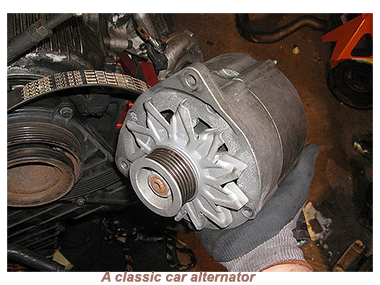 Maintaining the alternator on a classic car can help ensure that it continues to operate effectively and prolong its lifespan. Here are a few steps you can take to maintain your classic car's alternator:
Maintaining the alternator on a classic car can help ensure that it continues to operate effectively and prolong its lifespan. Here are a few steps you can take to maintain your classic car's alternator:
- : The alternator is typically driven by a belt that connects it to the engine. Over time, this belt can become loose or worn, which can cause the alternator to malfunction.
 The fan belt must have the appropriate tension in order to prevent it from slipping, binding, or snapping. It is important to check the tension of the belt on a regular basis and immediately after installing a new belt to ensure that it is within the parameters specified by the manufacturer.
The fan belt must have the appropriate tension in order to prevent it from slipping, binding, or snapping. It is important to check the tension of the belt on a regular basis and immediately after installing a new belt to ensure that it is within the parameters specified by the manufacturer.
( It is good advice that after fitting a new belt in place, to check it again after a week to make sure that the tension has not been compromised.)
Determine the belt tension levels by measuring the amount of deflection. This is done by placing a straight edge flush along the fan belt. Measure the distance between the belt and the straight edge by pressing down firmly on the belt with your finger or the end of a ruler and then reading off the distance. Check this measurement against the recommended deflection measurements that are listed in the owner's manual.
Inspect the belt regularly and make sure it is tight and in good condition.
- Keep an eye on the charging system: The alternator's job is to charge the battery and provide power to the electrical system while the engine is running. When you start your vehicle, make sure to listen.
 If it takes a while to start, it's possible that your battery does not have enough charge to power your vehicle effectively, which will damage the charging mechanism.
If it takes a while to start, it's possible that your battery does not have enough charge to power your vehicle effectively, which will damage the charging mechanism.
Regularly checking the battery's charge level and making sure all the lights and other electrical components in the car are working properly.
 Inspect the bearings: The alternator has bearings that support the rotor and help it spin. Over time, these bearings can wear out, which can cause the alternator to malfunction.
Inspect the bearings: The alternator has bearings that support the rotor and help it spin. Over time, these bearings can wear out, which can cause the alternator to malfunction.
In a normal situation, the rotor shaft of the alternator needs to have two deep groove ball bearings put on it. The location of the rotor is determined by the bearings that are positioned on the drive end (pulley side).
Listen for any unusual noises coming from the alternator, such as grinding or squealing, which can indicate that the bearings need to be replaced.
- Clean the exterior of the alternator: dust can gather on alternator's exterior which will decrease its cooling efficiency. Clean it with a soft brush or rag and some electrical contact cleaner.
 Watch for warning signs: If your car's battery is not charging properly, or if you notice that the car is having trouble starting, or if the alternator warning light on the dashboard comes on, these are signs that the alternator may be malfunctioning and needs to be checked.
Watch for warning signs: If your car's battery is not charging properly, or if you notice that the car is having trouble starting, or if the alternator warning light on the dashboard comes on, these are signs that the alternator may be malfunctioning and needs to be checked.
- Regularly inspect and replace the drive belt at least once a year, or as required.
- Regularly check the alternator's voltage output. If there any issues with the alternator, check it out with an experienced auto electrician for further testing and diagnosis.
By following these steps, you can help ensure that the classic car's alternator continues to function properly for many years to come.
Back to the homepage- and don't spare the horsepower.
br4





